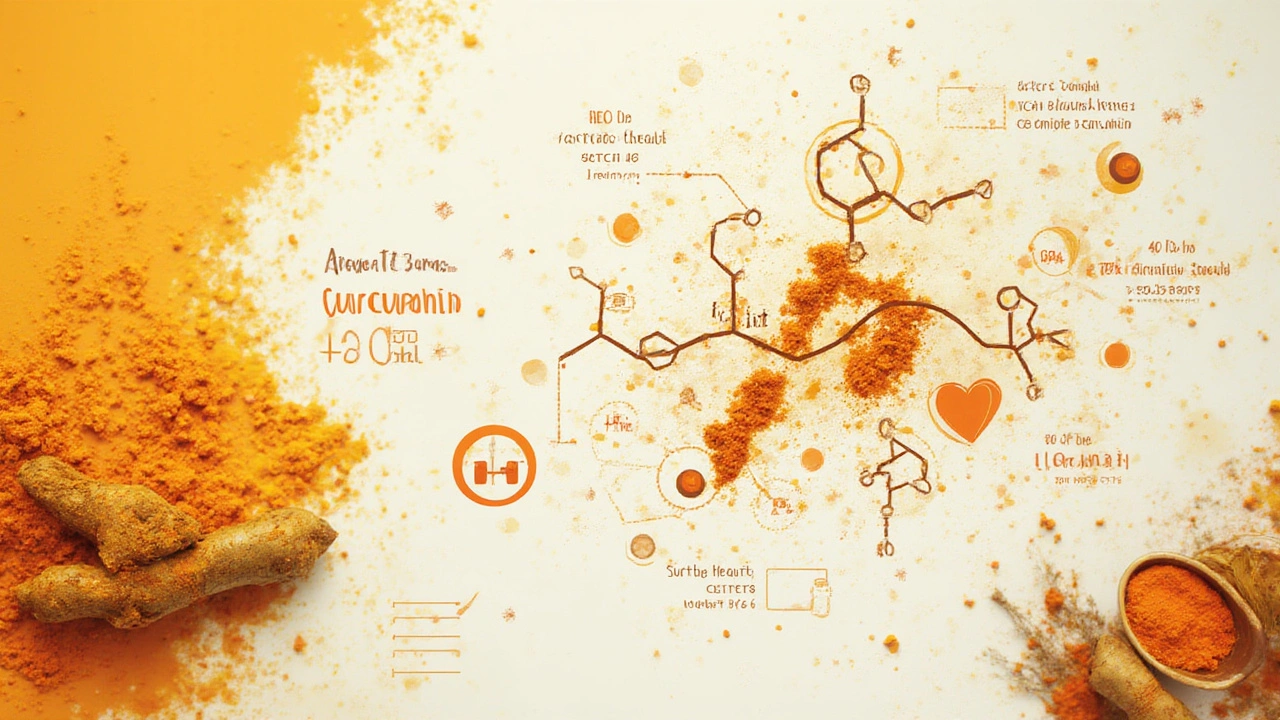Your spice rack might be hiding a hero. Not that bottle of cinnamon you never reach for, but that golden-yellow powder: haridra. Americans call it turmeric. In my grandma’s kitchen, this stuff was practically sacred, but I never guessed just how much modern science would come to rave about it. There’s more going on than curry’s gorgeous color—let’s get to the heart of what makes haridra such a big deal, why researchers keep testing it, and how even busy parents like me (with a kid who’d rather eat pizza) can sneak a spoonful of wellness into our routines.
The History and Science of Haridra
If you’ve ever tried a bright yellow curry or sipped on golden milk, you’ve met haridra. For over 4,000 years across India and Southeast Asia, haridra was never just a seasoning—it was medicine, ritual, and even dye for wedding saris. Ayurvedic texts talk about it like it’s the Swiss Army knife of healing herbs: clearing skin, soothing throats, and even calming upset tummies from too much street food. The name 'haridra' itself hints at golden color and purity, which is symbolic in Indian culture. Isn’t it wild that something you sprinkle on rice shaped centuries of tradition?
So why does this root get so much attention from scientists today? It’s all about curcumin, haridra’s star compound. Curcumin is a powerful antioxidant and anti-inflammatory, and it gives turmeric its vibrant color. Researchers have found that this natural compound can interact with multiple biological pathways in the body—unlike many single-purpose drugs. There’s a *ton* of published research—over 10,000 articles just focused on curcumin and health. Harvard Medical School even wrote that curcumin might rival certain prescription anti-inflammatories—without the pesky side effects.
One of the coolest things? In many parts of India where turmeric is eaten daily, illnesses tied to chronic inflammation—things like heart disease and arthritis—have historically been less common, though lots of other cultural and dietary factors are involved. No one’s saying haridra is magic. But the correlation is enough to make health majors perk up and reach for their pestle and mortar. Even Farrah’s science class teacher sent home an optional project based on household spices and their effects on cell structure. (Yes, I felt weirdly validated as a parent after reading that email.)
| Country | Average Daily Turmeric Intake (mg) | Chronic Inflammatory Disease Rate (%) |
|---|---|---|
| India | 2,000 | 6.0 |
| United States | <200 | 24.7 |
| Japan | 1,000 | 10.5 |
Sure, those numbers don’t prove causation (and no, Japan doesn’t put turmeric in their sushi), but it’s pretty striking. Plus, turmeric roots have dozens of other good-for-you compounds—hundreds of tiny phytochemicals. Nature just seems to pack all kinds of gentle, supportive goodness into this one unassuming root.

Health Benefits You Can Actually Feel
Most of us are just looking for simple, real ways to feel better—sleeping longer, digesting easier, staying active. Haridra, or turmeric, isn’t just pushed by mystics or influencers—it’s now a focus for clinical studies around the world.
- Joint Health: Many years ago, my first yoga class left my knees groaning for days. Turmeric helps here. A 2021 meta-analysis out of the Journal of Medicinal Food found people with osteoarthritis who took 1,000mg of curcumin daily noticed real pain relief—on par with over-the-counter ibuprofen, minus the stomach issues. It doesn’t work overnight, but even my uncle with creaky elbows swears his joints are less stiff after adding turmeric to his lunch dal for a month.
- Digestive Support: Ever regret that second plate of nachos? Turmeric can ease an inflamed gut. Clinical studies show haridra helps calm down irritable bowels and reduces bloat, especially in people with mild IBS. Its bitterness isn’t just for taste—it signals the body to release enzymes and get things moving along, in a good way.
- Immune Boost: So many parents are always bracing for that classroom cold. Curcumin increases production of immune cells and can even lower respiratory infection rates, according to studies run during the COVID-19 pandemic. I started tossing a pinch into Farrah’s omelet when sniffles started up, and—maybe it’s a placebo, maybe not—she bounced back quicker.
- Brain Health and Mood: There’s newer research hinting at haridra’s effects beyond just the physical. Some reports link consistent turmeric intake with lower rates of depression, likely thanks to its anti-inflammatory powers. There’s curiosity about how it might protect our brains as we age, though this research is still evolving. Either way, golden milk lattes are a delicious pick-me-up on tough days.
- Glowing Skin: Indian bridal routines use turmeric face masks for good reason—the curcumin fights bacteria and soothes redness. I tried it once—Farrah laughed at my "Simpsons face"—but my skin felt softer, and a lingering spot faded faster than usual.
Because the body doesn’t absorb curcumin well on its own, there’s a trick: pair turmeric with black pepper (which contains piperine), or add a fat like coconut oil or ghee. This can boost absorption by up to 2,000%! That’s why many traditional curries combine these ingredients. No need for fancy supplements or pills—though if you go that route, double-check the label for both curcumin AND piperine. Otherwise, you’re tossing money after yellow powder that mostly leaves your body the same way it entered.
Here’s what a smart daily dose looks like for most adults, based on the data doctors use:
- Quarter to half a teaspoon of turmeric powder, with a chunky grind of black pepper, mixed into food or warm drinks.
- Or, if using turmeric root, about 1-2 grams (a thumb-sized piece) grated into smoothies or teas.
- Kids over the age of six can try half these amounts, but always check with a pediatrician if you’re worried about allergies or medications.
If you take blood thinners or have gallbladder issues, a quick check-in with your doctor makes sense. Turmeric is pretty safe for most, but like any herb, too much can cause tummy trouble in rare cases.

Smart Tips for Adding Haridra to Everyday Life
It’s easy to dream about turmeric-spiced lattes or golden curries when you have time on weekends, but life is rarely that organized. As a working mom, I need quick wins—ways to add healthy habits without losing my mind (or Farrah’s patience). Luckily, you don’t have to reinvent dinner to get your turmeric fix.
- Boost your eggs: Scramble a pinch of turmeric and black pepper into your morning eggs. Not enough to overpower the taste, but enough to turn sunny side yellower. My kid devours these with toast.
- Golden Milk: Heat a mug of regular or oat milk, add half a teaspoon of turmeric, three twists of black pepper, a sprinkle of cinnamon, and honey to taste. Whisk like crazy. It’s the ultimate bedtime calm-down drink. If you’re lactose-free, almond or soy work just as well, especially with a touch of maple syrup.
- Simple salad dressing: Shake olive oil, lemon juice, turmeric, black pepper, and a bit of salt in a jar. It’s bright and zesty, amazing on greens or roasted vegetables.
- Soup secrets: Anytime you’re making broth or soup, toss in some turmeric (start with a teaspoon per quart). It deepens the color and adds a subtle earthiness. Kids barely notice it, but the health benefits sneak in.
- Homemade energy balls: Blitz dates, walnuts, coconut, oats, turmeric, and black pepper in a food processor. Roll into little balls—kids love the golden color, and you’re packing in antioxidants with every snack.
- Face mask DIY: For the brave, mix plain yogurt, a pinch of turmeric, and honey into a paste. Smooth onto clean skin, let dry (don’t wear your favorite shirt—that stain is here to stay), and rinse after 10 minutes. It’s soothing, cheap, and somehow always earns bonus points for “mom being silly.”
When buying turmeric, not all powders are equal. Look for organic, brightly colored turmeric from a trusted brand or ethnic grocery—cheap stuff can be cut with fillers or not as fresh. If you can, try the root itself from specialty stores. Slice it thin, toss in hot water plus ginger for a zingy tea.
If you want to keep track—yes, some people do this—simple wellness trackers or journals can help you notice mood bumps, less creaky mornings, or faster recovery from minor bugs. The change isn’t always dramatic, but the science behind haridra is hard to ignore. Even a little every day might create a ripple effect across your health, your energy, and maybe even the family dinner table—all without dramatic life changes.
So next time someone asks why your oatmeal is glowing, you’ll know the answer. It’s not just a fad or a Pinterest trend, but a piece of ancient wisdom backed by real research and decades of moms who swear by the yellow stuff.

Kim Clapper
Okay but have you considered that turmeric might just be a placebo for people who need to believe in magic? I mean, my cousin took it for his arthritis and still ended up in a wheelchair. Also, why is everyone suddenly obsessed with Indian remedies? Did we run out of real medicine?
Bruce Hennen
There are multiple grammatical and structural inaccuracies in this post. For instance, 'haridra' is not an English word-it's Sanskrit-and its usage here is inconsistent with scientific nomenclature. Furthermore, the claim that curcumin 'rivals prescription anti-inflammatories' is misleading without specifying dosage equivalence, bioavailability metrics, or control variables. The table lacks standard error margins. This reads like a wellness blog masquerading as peer-reviewed literature.
Jake Ruhl
GUYS. I KNOW THIS IS GOING TO SOUND CRAZY BUT TURMERIC IS A GOVERNMENT COVER-UP. THEY DON'T WANT YOU TO KNOW THAT THE PHARMA COMPANIES ARE PAYING DOCTORS TO IGNORE IT BECAUSE IT'S TOO CHEAP AND NATURAL. I READ ON A FORUM THAT THE CIA USED TO TEST TURMERIC ON VIETNAM VETS TO SEE IF IT COULD MAKE THEM STOP FEELING PAIN SO THEY'D KEEP FIGHTING. ALSO MY DOG GOT STUNG BY A BEE AND I PUT TURMERIC ON IT AND NOW HE TALKS IN SONGS. I'M NOT KIDDING. I HAVE VIDEO. THE FEDS ARE COMING FOR ME BUT I'M NOT SCARED. I'M JUST A MOM WHO WANTS HER KID TO BE HEALTHY.
Chuckie Parker
India has a 24% poverty rate. Of course their inflammation numbers are low. They can't afford to get sick. They just suffer quietly. This post is cultural appropriation dressed up as science. We don't need your spice rack wisdom. We have FDA-approved meds. End of story.
Evelyn Shaller-Auslander
I tried golden milk last week. Slept like a baby. No joke. Thanks for the tip.
Gus Fosarolli
So let me get this straight-you’re telling me the secret to better health is... not eating junk and adding a spice that’s been around since the pyramids were new? Groundbreaking. Next you’ll tell me breathing oxygen helps. I’m in. Also, my kid calls it 'yellow dirt' and eats it off my spoon. Worth it.
George Hook
I’ve been using turmeric daily for five years now. Started after my back surgery when the painkillers made me nauseous. I began with half a teaspoon in my morning oatmeal, added black pepper, and slowly increased. Over time, I noticed reduced morning stiffness, better digestion, and even fewer seasonal colds. It didn’t fix everything-but it didn’t cost me a fortune either. I don’t take supplements. Just the powder. And I grind my own pepper. It’s not a miracle, but it’s consistent. And consistency, in health, is what actually matters.
jaya sreeraagam
As someone born in Chennai and raised with turmeric in every meal-breakfast dal, lunch sambar, dinner rasam-I can say this post is sweet but still too tame. We didn’t just use it for health-we used it for purity. Before weddings, girls were rubbed with turmeric paste to glow. Babies got it on their foreheads to ward off evil. My grandma said if you ate it every day, your soul stayed clean. Science now says curcumin. But we always knew it was more than chemistry. It was ritual. And ritual matters. Also, never buy powdered turmeric from Walmart. Buy from the Indian grocery on 5th. Fresh root, ground daily. That’s the real stuff.
Katrina Sofiya
This is such a beautifully written, thoughtful, and evidence-based piece. Thank you for sharing your personal journey alongside the science. It’s rare to find content that honors both tradition and research without overselling either. As a healthcare professional, I’ve recommended turmeric to dozens of patients-and this post captures exactly why it works: not as a cure-all, but as a gentle, consistent ally. Keep spreading this kind of wisdom.
kaushik dutta
Let’s be clear: the anti-inflammatory efficacy of curcumin is mediated via NF-kB pathway inhibition, COX-2 downregulation, and modulation of TNF-alpha cytokine expression-mechanisms that are well-documented in PubMed-indexed RCTs. However, the bioavailability issue remains a critical pharmacokinetic limitation. Most commercial turmeric powders contain less than 3% curcuminoids. To achieve therapeutic plasma concentrations, you need liposomal formulations or nanoemulsions. The black pepper synergy is real-but piperine inhibits CYP3A4, which can interfere with statins, SSRIs, and anticoagulants. So yes, turmeric is powerful-but it’s not a pantry panacea. It’s a phytochemical with clinical implications. Use it wisely.
doug schlenker
I appreciate how this post doesn’t try to sell turmeric as a miracle. It’s honest. I’ve had friends who swear by it and others who saw zero change. I think the key is consistency and context. If you’re already eating well, moving, and sleeping? Turmeric might nudge you forward. If you’re living on fast food and caffeine? No spice in the world will fix that. Also, I tried the face mask. My skin didn’t glow-but my partner laughed so hard he cried. So, win-win.
Olivia Gracelynn Starsmith
My mom used to mix turmeric with honey for sore throats. I hated the taste but now I’m 38 and I do it myself. I don’t know if it works but it makes me feel like I’m doing something right. Also I added it to my coffee this morning and it tasted like dirt. Worth it.
Skye Hamilton
...I just realized I’ve been eating turmeric for years and never knew it was called haridra. I thought it was just ‘that yellow spice’. And now I feel like a cultural ignoramus. Also, why does everyone act like this is new news? My grandma used it in everything. We didn’t need a blog to tell us it was good. We just knew. And now I feel weirdly guilty for not crying about it.
Maria Romina Aguilar
Wait-so you’re saying that a spice... that’s been used for thousands of years... might actually have medicinal properties? And you’re surprised? And you’re shocked that science is catching up? And you think this is revolutionary? And you think people will believe you? And you think this post isn’t just... repeating what every grandmother in the world already knew? And you think you’re being original? And you think this isn’t just... cultural rebranding? And you think this isn’t just... capitalism repackaging tradition? And you think you’re not just... selling a feeling? And you think you’re not just... profiting off nostalgia? And you think this isn’t just... the same old story? And you think you’re not just... repeating yourself? And you think you’re not just... wrong?
Brandon Trevino
Let’s dismantle this post. First, the table: correlation ≠ causation. Second, the 10,000 studies? 9,800 of them are in vitro or rodent models. Third, the ‘2,000mg daily intake’ in India? That’s an average across a population of 1.4 billion, many of whom eat turmeric once a week. Fourth, the bioavailability claim? 2,000% increase with piperine? Only under controlled lab conditions with isolated curcumin. Real food matrices reduce absorption by 80%. Fifth, the ‘glowing skin’ claim? That’s anecdotal. Sixth, the ‘immune boost’? No RCTs show turmeric reduces viral transmission. Seventh, the ‘no side effects’? Hepatotoxicity cases reported in supplement users. Eighth, the ‘grandma knew’ argument? Appeal to tradition fallacy. Ninth, the tone? Emotional manipulation disguised as wellness. Tenth, the entire post? A monetized myth wrapped in sentimentality. Do better.
Denise Wiley
I love this so much. I’ve been adding turmeric to my smoothies since my knee surgery and honestly? I feel like a new person. Not because it’s magic-but because it reminds me to slow down, make something warm, and care for myself. Also, my 7-year-old now calls it ‘sunshine powder’ and asks for it every night. That’s the real win. Thank you for writing this. You made me feel seen.